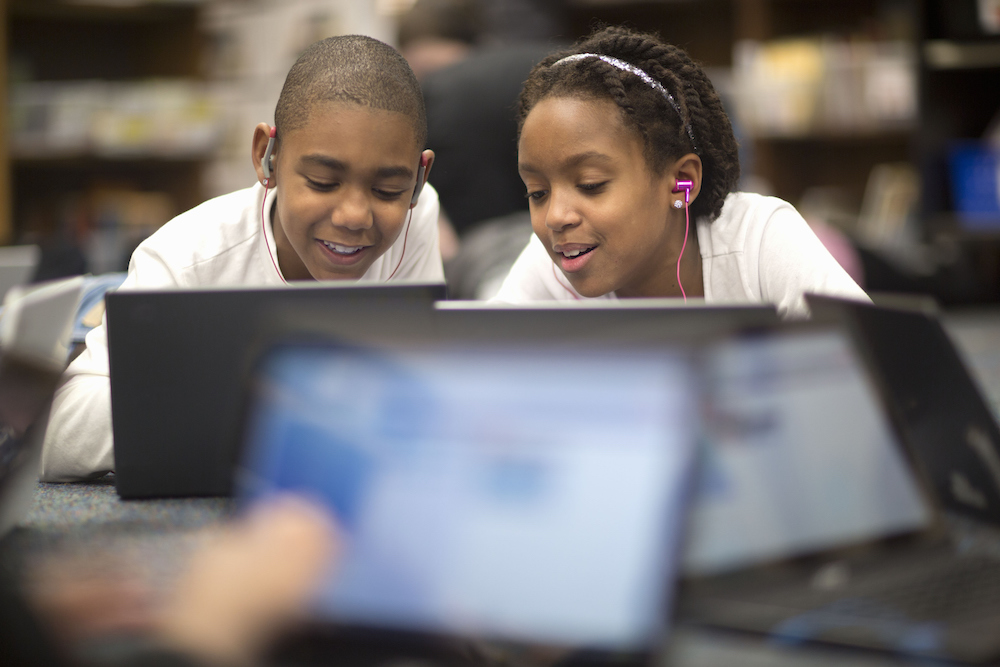Lesson 2: Privacy and You
Before you start the lesson, make sure to read through the lesson overview and the lesson preparation. The Facilitator Guide can also help you prepare.
Lesson Overview
Students will explore what kinds of information might be best kept “private,” how to customize privacy settings on social media, and how to explain their decision-making process for their settings (e.g., why certain content is set to “friends only” vs. a “public” setting).
Lesson Preparation
ESTIMATED TIME
ESSENTIAL QUESTIONS
- How do you decide what information to share (and not share) online and with whom to share it?
- What role does social media play in your choices?
MATERIALS
- “Guessing Game” Handout
- “Guesses” Handout
PREPARATION
- Print one handout per student.
- There are opportunities to localize content to your students’ experience and local context. These opportunities are flagged as a “Teacher’s Note.” We suggest you read through the lesson ahead of time and prepare the examples before the lesson begins.
OPTIONAL: ISTE DIGCITCOMMIT COMPETENCY
- ALERT: I am aware of my online actions and know-how to be safe and create safe spaces for others online.
- INCLUSIVE: I am open to hearing and respectfully recognizing multiple viewpoints and I engage with others online with respect and empathy.
Guessing Game
Part 1
CLASS INTERACTION
Pass out the “Guessing Game” handout and ask each student to fill it out. Ask students to choose four pieces of information to share and let them know that you will share the information they write with the entire group. Instruct them to keep the second sheet.
Give students 10 minutes to complete the handout. Afterward, collect the handouts.
TELL YOUR STUDENTS
Now I am going to read some of the information on each handout. Use the Guesses section to write down your guess about which student filled out each handout.
CLASS INTERACTION
After going through the handouts, engage the group in a discussion.
ASK YOUR STUDENTS
- Were there any pieces of information that you did not share with anyone? Which ones? Why?
- Did everyone make the same choices about what to share? Why/why not?
- Depending on whom you share with, why might you share more, or less, of this kind of information? When would you share it?
- How easy was it to connect each piece of information to the person who wrote/said it?
- Were there instances where a given response might have inadvertently conveyed something beyond the actual response (e.g., someone might have disclosed their favorite food, which might have given some indication as to which culture(s) this person is familiar with)?
- What assumptions do you think other people might make about you if you shared the information you wrote down as part of the Guessing Game with the wider world?
Part 2
TELL YOUR STUDENTS
Privacy is the ability to control what other people know about you. You can do this by saying certain things about yourself (like telling other people your address or what you like to do for fun) or doing things around other people (like going to a store with your friends and picking out what you want most). Privacy matters whether you are in a room with other people or talking to them online.
Privacy is based on your own personal decisions. What privacy means to you and your family might be very different than what privacy means to other people in this group and their families. If we’re more aware of what we value as private and how our behaviors online can shape our privacy, we’ll be able to make better choices about what kind of privacy we want. Privacy also changes depending on the type of information being shared and with whom it is being shared.
ASK YOUR STUDENTS
For example, would you share your home address with:
- Your parents/guardians or other important adults in your family?
- Your friends?
- Your teacher?
- A stranger/person you don’t know well?
- A friend of a friend?
- An organization or company?
Summary
TELL YOUR STUDENTS
When you share information online, it’s important to consider who could see that information and whether you or the person whose information is being shared feel comfortable sharing that particular information with certain audiences. Some information could mean bad things in the future if it’s shared with the wrong people. If a stranger/person you don’t know well knows exactly where you live, then he or she could come to your house, which could be unsafe. While this might be more or less likely in different parts of the world, the risk (and potential harm) may outweigh the low probability that it could actually happen. In order to recognize the privacy choices that will keep you safe, you need to understand what the effects of sharing information are.
Miscommunications Discussion
TELL YOUR STUDENTS
Let’s talk about what we say in text messages, how we say it, and how it can be different than communicating in person.
ASK YOUR STUDENTS
- How can saying something over text be different from saying it in person?
- Possible answer: If you can’t see the person’s reaction, you may not know how they felt about what you said. You might hurt someone’s feelings without realizing it.
TELL YOUR STUDENTS
When talking to someone face to face, you can observe their reactions when you speak to them, including body language and tone of voice. Some of that context is lost when communicating online. However, online you may gain other types of contextual information that could help with communication (e.g., platforms may have specific norms that give you a better sense in terms of how information is interpreted).
ASK YOUR STUDENTS
- If you lack certain contextual cues (e.g., body language, tone of voice), how might this lead to your texts or other online messages being misunderstood by the receiver (e.g., a joke might be misconstrued and hurt someone’s feelings)?
- If you were misunderstood in a face-to-face conversation, what would you do to clear up the misunderstanding (e.g., you could apologize or explain what you were trying to say)? How might this be different (i.e., harder or easier) over text message?
Who is your Audience?
Part 1
TELL YOUR STUDENTS
While we will inevitably leave a trail of data from our online activities, there are some ways we can control our privacy and manage our online reputation. In a social media context, there are often settings incorporated into the platforms that allow us to choose who can see what we post. Although adjusting these settings does not limit analysis — including metadata analysis — from, for instance, third-party groups (e.g., advertisers, researchers, or companies) as well as the platforms themselves, it can often limit what other social media users may see or what information companies or advertisers may access.
For those who are curious, metadata is basically data about data. Metadata can include, but are not limited to, things such as what time you log on to a social media platform, your location when you logged in, and information about your online connections. Privacy settings may look different on each social media platform, but they help us define our audience. For instance, settings may allow our posts to be completely public, visible only to friends of friends, restricted to just one’s friends, and, sometimes, only visible to certain selected friends. Other types of functionality that these settings may impact include location data and sharing permissions. Cookies, targeted advertising, and search completion can all be disabled on most services through some changes in options/settings on each service.
There are also web browser extensions and other digital services available that can strengthen your privacy protection as you move between websites (e.g., Privacy Badger “Do Not Track” extension from the Electronic Frontier Foundation).
Part 2
CLASS INTERACTION
Divide students into pairs.
ASK YOUR STUDENTS
- Take a minute to think about all the social media platforms where you each have an account. Do you know what your current privacy settings are on each of these social media platforms?
Group Activity
TELL YOUR STUDENTS
Let’s explore the capabilities that these settings provide and figure out which ones are most appropriate, in which situations, and on what platforms. Individually, go to a social media platform you use and check your privacy settings. Usually, the privacy settings can be found under your account settings, and some platforms even include special functions for checking your privacy.
After examining your privacy settings, talk to your partner about these settings. Why does each of you have your privacy settings the way that you have them? Are privacy settings sometimes contextual (e.g., certain settings are appropriate in one case but not necessary in another)? Have you ever changed your settings? How often do you change them and why?
Make sure you are looking at both the privacy settings related to sharing information with different people on the platform, as well as those that indicate how much data the platform itself and any associated third parties (like advertisers) may receive. All are important aspects of controlling your digital privacy — for strangers/people you don’t know well, friends, family, and companies.
Discussion
ASK YOUR STUDENTS
- Is your overall account set on public, private, or something else?
- How did you decide on this setting?
- Are your current privacy settings what you want them to be?
- When does it make sense to have public sharing, and when might private settings be preferable?
- Do you feel comfortable sharing your information with the social media platforms you use or the companies advertising on these platforms? Why or why not?
- Does this conversation make you think differently about your privacy settings? Why or why not?
Assignment
TELL YOUR STUDENTS
Now that we have talked about privacy, what people can distill based on the content we share, how messages can be understood differently by different people, and why settings may be helpful as a tool to decide what you would ideally like to share with a specific audience, let’s apply what you’ve just learned.
Over the next 30 minutes, individually, reflect on the following three scenarios and write a short paragraph response for each.
Tsehay is 13 years old, and she just started to explore singing. She feels that she is not that great at it yet, but she would like to share her new passion with her friends and get their input on it. She is considering adding some videos of her singing some of her favorite songs on a social media platform. What type of platform would you recommend? Does she need parental consent? What do you think would be the ideal privacy settings for that platform? Please explain why.
Obinna is 16 years old, and he is passionate about cooking and creating new recipes. He has worked on several local dishes like Egusi Soup and Fried Egg and Yam that he is very excited about, and he would love to share the ingredients and how they are prepared with his friends and other people interested in cooking. What type of platform would you recommend? Does he need parental consent? What do you think would be the ideal privacy settings for that platform? Please explain why.
Fatuma is an 18-year-old girl who just graduated from secondary school, and she wants to start looking for a job next month. She loves computers and wants to get a job in the IT sector. However, she doesn’t know what jobs are available to her. She is aware that employers will want to see a CV but she doesn’t know how to write an effective one. She would like to meet with people who have similar plans so she can get advice and recommendations on how to go about the process. What type of social media platform would you recommend for Fatuma? Does she need parental consent? What do you think would be the ideal privacy settings for that platform to enable her to achieve her goal? Please explain why.
Teacher's NoteThe goal of these examples is to teach students to identify different social media platforms and the ideal privacy settings needed to ensure the characters achieve their goals. The names and the examples can be further localized to reflect common names and situations in the area you are teaching. For example:
- Ethiopia: Tsehay, Meskerem, and Michael
- Kenya: Amani, Onyango, and Fatuma
- Nigeria: Obinna, Akpan, and Babatunde
- Zambia: Twaambo, Walusungu, and Kayla
Assignment
If possible, the next time you reconvene as a group, have students divide into the same pairs and let each pair share their assignment reflections. Give students 30 minutes to finish this assignment. This assignment can be done in class or as homework.
Congrats!
You've finished the lesson
Source:
This content is hosted by Meta and currently includes learning resources drawn from Youth and Media at the Berkman Klein Center for Internet & Society at Harvard University under a Creative Commons Attribution-ShareAlike 4.0 International license. You can make use of them, including copying and preparing derivative works, whether commercial or non-commercial, so long as you attribute Youth and Media as the original source and follow the other terms of the license, sharing any further works under the same terms.



 Previous Lesson
Previous Lesson 




